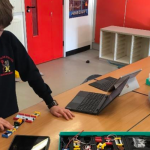One of the key tasks of parents and educators is preparing children for life by supporting the development of problem-solving skills. From inconveniences of daily life to abstract academic puzzles and questions, good problem-solving skills are a must-have in different situations.
In this article, we will talk about what we mean by problem-solving skills, why it is important, and suggest different kinds of interactive problem-solving activities for kids.
Problem-Solving Skills in Kids
According to a recent report, one of the most commonly lacking soft skills among young people who recently finished college is problem-solving skills. A lack of good problem-solving skills results in avoiding challenges and conflicts that are necessary for a fulfilling life. It can hinder individuals from reaching their full potential and flourishing in various environments.
Problem-solving skills should be cultivated starting from childhood so that kids grow into self-sufficient adults who are capable of navigating through various challenges of life. Developing problem-solving skills at younger ages helps children become more independent, pick up other essential 21st century skills, and gain resilience.
What are Problem-Solving Skills?
Problem-solving is the process of using actionable knowledge to produce a favourable outcome out of a challenging situation. Problem-solving skills go hand in hand with various skills such as teamwork, social skills, critical and analytical thinking, creativity, decision-making, negotiation, cooperation, anger management, and conflict resolution.
How to improve problem-solving skills in kids?
The key to problem-solving skills development in kids is to practice solving problems. Of course, this might not be very pleasant by itself. You can turn it into a pleasant experience by gamifying the process with various activities and integrating such activities into everyday life.
5 Steps of Problem-Solving
Dividing the problem-solving process into steps can help them easily follow through. Here are five problem-solving steps to try out:
- Break down the problem. A clear grasp of the problem helps come up with well-targeted solutions. Try to define it and understand the details. What are the circumstances? Who does it affect and how?
- Brainstorm possible solutions. After having a well-defined problem at hand, you can start brainstorming. At this step, don’t focus on the specifics. Simply list the ideas that come up. You can use post-its!
- Assess the pros and cons of each solution. Now is the time to think of the possible outcomes of the solutions. Does it work for everyone involved? Is it easy to implement, and if not, is the effort worth the outcome?
- Decide on a solution. After carefully assessing each solution, pick the one that works the best. Here, you can start planning how the solution can be realized. What do you need to make it work? What are your backup solutions?
- Put it to test. Finally, you can implement the solution you have decided on. Observe how it plays out and discuss the results! Did it go as expected? What could be done differently? If the outcome does not match your expectations, try out other possible solutions or start the process again with the experience you gained on the first attempt.
Creative Problem-Solving Activities
Building Blocks
LEGO blocks, magnetic blocks, wooden blocks, or even materials such as play dough allow children to explore part-whole relationships in a creative way. It promotes thinking about design and function, how smaller parts come together in a way that makes sense and therefore helps develop problem-solving skills.
For children aged 6 and beyond, you can try out Twin STEM kits which are compatible with LEGO blocks for infinitely more combinations that can address real-life problems. For example, with the Twin Curiosity Kit, they can create their own smart security system or smart pet feeder!
Pillow Forts
Who doesn’t love this age-old classic! Fond memories of messing up the living room with blankets and pillows must have come up in your own mind. In addition to being a cozy and fun activity that can easily be done in every home, it has many pedagogical benefits, including problem-solving skills.
Allow children to create their own forts in an unstructured way. Try not to interfere unless they really demand your help. While building their architectural masterpiece, children will think through logistic details–how to make it a durable structure that’s comfortable enough for them to sit inside, which materials to use and where etc.
The process of building pillow forts involves a lot of trial and error. Things may not go as they plan. What they have in mind may not be easy to bring to life. As they build, they will have to solve spontaneous design problems. The results (and the process itself) are always very much satisfying!
Functional Problem-Solving Activities
Mazes
Solving mazes is a fun, functional problem-solving activity suitable for all ages and levels. It encourages children to think three-dimensionally, engages their spatial and motor skills, and sense of direction.
There are plenty of maze games you can find online with different levels of difficulty. You can make it more encouraging by putting rewards and prizes per completed maze. Gotta appreciate the hard work that the little ones put in!
Social Problem-Solving Skills Activities
Roleplaying
Write out different scenarios on small index cards describing a social problem. It could be about friendship problems, conflicts with family, or various situations at school, in the classroom, at lunch, in the park, etc.
Then, ask your child to pick one and act it out together. You can switch roles to take it a step further. This will engage their imagination while improving social problem-solving skills and empathy and help them prepare for future social conflicts.
Emotions in a Jar
Even as adults, we tend to struggle with strong and difficult emotions. It comes up as a challenge both as part of our relationship with ourselves and of our social relations with others. Emotional regulation is an essential skill that needs to be carefully nurtured at younger ages.
In this problem-solving activity, you will need some jars and different colored pom poms (or other kinds of soft material). Each jar will represent a certain emotion: anger, happiness, excitement, frustration, sadness, etc. You will then have them fill any jar they want with pom poms, according to how intensely they feel it.
As they do it, talk about what these pom poms represent. Maybe they lost their favorite toy and want to put a handful of pom poms into the sadness jar. You can revisit the jars and ask if they would want to take away some of the contents over time.
Coding games
Learning to code through games is a perfect way to develop problem-solving skills for children. It combines fun and challenges to create a motivating, fruitful learning opportunity. Through coding, children actively come across practical challenges and problems and come up with creative ways to overcome them.
You don’t even need any pieces of equipment to try out coding as a problem-solving activity. Check out our article on screen-free coding activities for kids to get some ideas.
Problem-Solving Activities for Kids in Groups
Group Building
Divide children into teams of three. Build a random structure using materials you have at hand. One person will try to rebuild this structure without seeing it. One person will see the structure, but not be allowed to talk about it. Another person will be the “talker”.
The “viewer” will describe the structure to the “talker”, without nonverbal communication. The talker will then describe what they understood about the structure to the builder. This is a great problem-solving activity for learning about conflict resolution through teamwork and collaboration.
Silent bench
Have children line up on a bench (a line on the ground drawn with chalk). Now, ask them different questions and order themselves accordingly without speaking. For example, from lightest to darkest according to their eye colours. This will require them to communicate nonverbally and be careful to keep their balance and not fall off the bench while moving around the line!
You can gradually increase the difficulty by giving them cues that are hard to communicate without speaking to each other. It is nevertheless a fun exercise for everyone involved!



